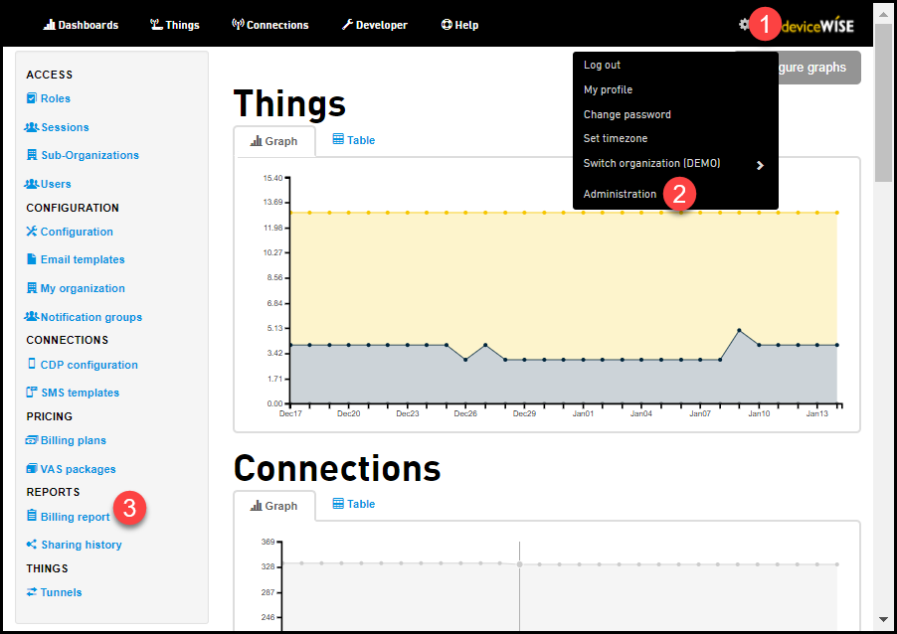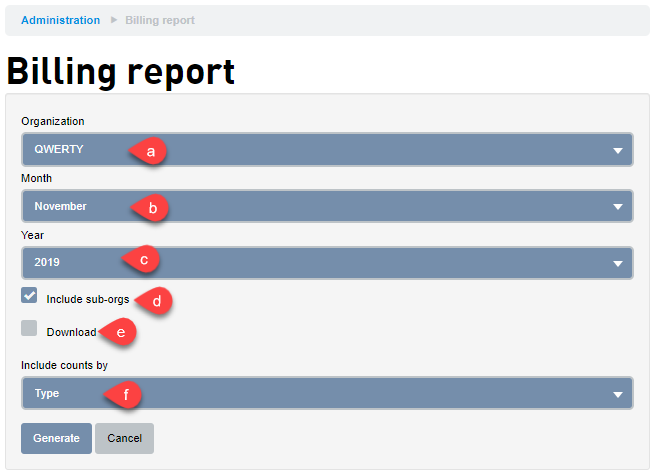Generating a Billing report
To Generate a billing report, do the following:
- Click the
 >> Administration on
the top right corner of the Management Portal
>> Administration on
the top right corner of the Management Portal
Administration screen appears. - On Administration screen
in the REPORTS group, click on the
Billing report
The Billing report screen appears. - On the billing report page, select the
following

- Select the Organization that you want to acquire the report for.
- Select the Month that the report should cover. By default, the previous month of the year is selected.
- Select the Year that the report should cover.
- Check Include sub-orgs to include sub-organizations of the selected organization. By default, the Include sub-orgs is selected.
- Check Download if you want to get the report in CSV format (Excel compatible).
- Select the counts by option: you can choose None, Include counts by thing definition or Include counts by type if you want to include the number of Things (and billable Things) per Thing definition or Type to the report.
- Click Generate to generate the
report.
The generated report contains two components. The report header, and the report data.
The Report header contains information about the contents of the report based on the parameters you specified.- The start row is the beginning date of the report.
- The end date is the end date of the report.
- The orgId is the unique identifier of the selected organization.
- The orgKey is the identifier of the selected organization.
- The orgName is the name of the selected organization.
The Report body contains the billing information for the parameters specified.
- The orgKey column contains the identifier of the organization and sub-organization
- The parentOrgKey is the identifier of the parent organization
- The countBillableThings is the number of things that have been connected to the platform in a Billing cycle. Billing cycle begins on the 1st day of the month 00:00:00 and ends on the last day of the month at 23:59:59 (UTC).
- The countThings is the total
number of things on the platform.
- Things are counted as the number of unique things (ThingId) that have been connected at any point in time during the current billing month. Things that are deleted before the end of the month are excluded from billing.
- The Things/ Connections that are created but never connected to the platform are not billable.
- The countConnections is the total number of connections on the platform.
- The countApiCalls is the number of
total API calls made in the organization.
- API calls are accumulated throughout the month and are counted regardless of the success or failure of the API call.
- Monthly connection fees include a specific number of API Calls per Thing. API Calls are measured by Organization (total Organization API Calls for the total number of Things). If the Organization average is above the allotted number of API Calls per Thing, additional fees will apply.
- The countStorage is the total amount of storage used by the organization. Data storage is measured as the average daily amount of storage, rounded up to the nearest GigaByte (GigaByte = 2^30 bytes) used within the customer's organization.
If you check Include counts by Thing definition while generating the report, you will see the following columns:
- The orgKey column contains the identifier of the organization and sub-organization
- The defKey column contains the identifier of the organization and sub-organization
- The countBillableThings column contains the number of billable Things associated with the Thing definition defined by defKey.
- The countThings column contains the total number of Things associated with the Thing definition defined by defKey.
If you check Include counts by Type while generating the report, you will see the following columns:
- The orgKey column contains the identifier of the organization and sub-organization
- The Type column contains the type of devices: gateway, lwm2m, lora, or generic.
- The countBillableThings column contains the number of billable Things associated with the Type.
- The countThings column contains the total number of Things associated with the Type.